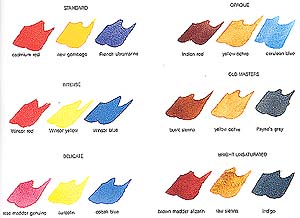Watercolor brushes revisited
Labels: art supplies, tutorials, watercolor

Nita Leland's blog is about her creative and family life, including book reviews, art links and essays on color, creativity, watercolor, writing, teaching and other subjects.
Labels: art supplies, tutorials, watercolor
Labels: motivation, quotation
Labels: art therapy, collage, new york times, picasso
Labels: quotation, soul/spirit

Labels: color, exploring color, tutorials
Labels: color, color mixing, green, tutorials, watercolor
Labels: creativity, talent
Labels: confidence, criticism, motivation
Labels: creativity, quotation
Labels: art business, photography
Labels: artist, confidence, motivation, quotation, self discipline
Labels: artist, communication
Labels: photography, quotation, seeing
Labels: motivation, picasso, quotation, self discipline, talent
Labels: confidence, motivation, quotation, talent
Labels: paint, paint quality, tutorials, watercolor
Labels: color, color mixing, color theory, color wheel, tutorials
Labels: prints/reproductions, tutorials
Labels: idea, motivation, quotation
Labels: color, green, paint, palette, prints/reproductions, tutorials
Labels: creativity, motivation, quotation
Labels: art magazines, creativity, motivation
Labels: creativity, motivation, quotation
Labels: art museums, artist, drawing, van gogh
Labels: beginner, watercolor
Labels: art mediums, paint, tutorials, watercolor
Labels: artist, realism, watercolor
Labels: happiness, motivation, quotation
Labels: artist, creativity, watercolor, workshop
Labels: art mediums, artist, value, watercolor, workshop
Labels: artist, design, value, watercolor, workshop
Labels: art organizations, artist, design, value, watercolor, workshop
Labels: artist, design, expression, watercolor, workshop
Labels: communication, quotation
Labels: art supplies, exploring color, tutorials
Labels: creativity, quotation
Labels: art supplies, workshop